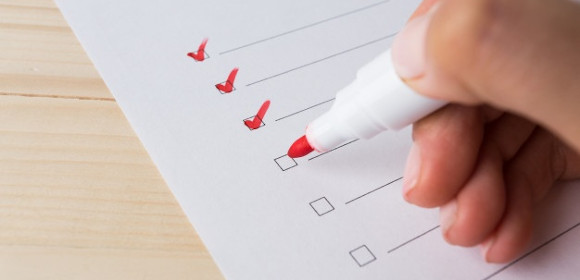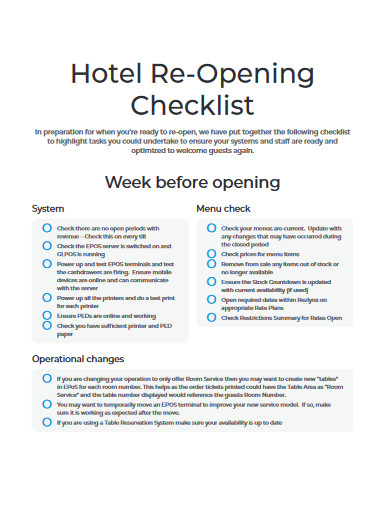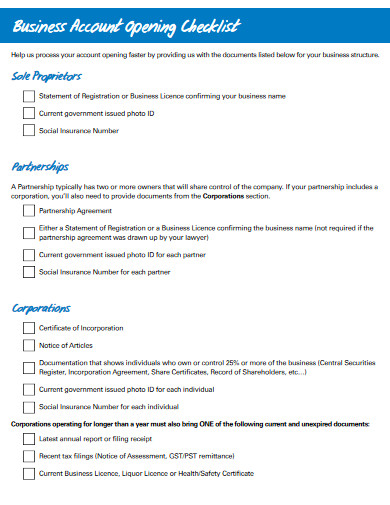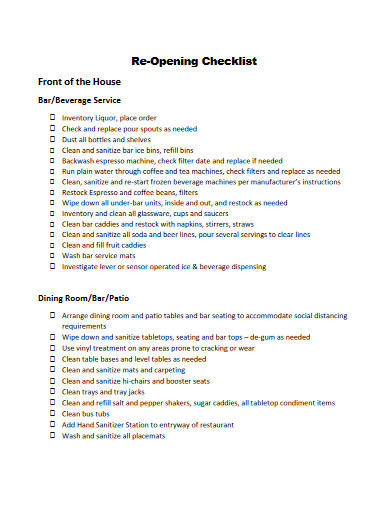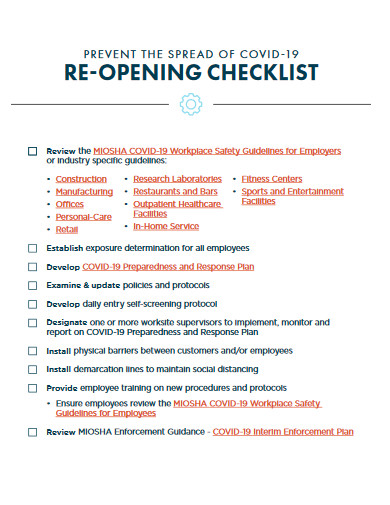9+ Opening Checklist Examples to Download
All business will start with an idea. However, you will need more than that to make your dream business into reality. Running a restaurant, store, or company includes much more than offering a delicious menu, hiring employees, and providing a satisfying dinner. It always requires a massive amount of planning and coordination to go off without a glitch. That’s why it’s vital to create an efficient opening checklist.
Since not everyone knows how to create one, we provide you some examples below.
9+ Opening Checklist Examples
1. Opening and Closing Checklist Template
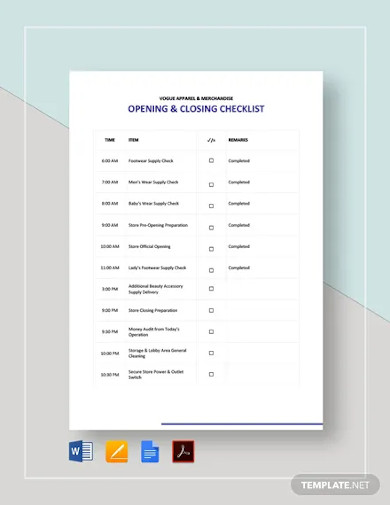
2. Restaurant Opening Checklist Form Template
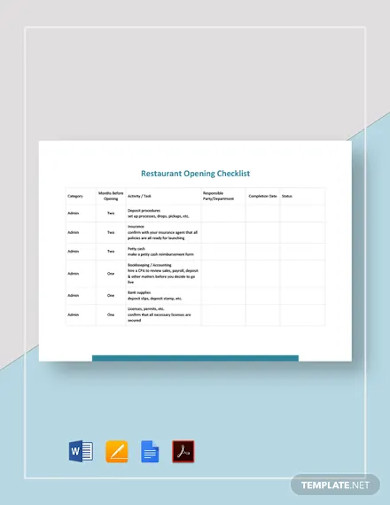
3. Restaurant Opening And Closing Checklist Template
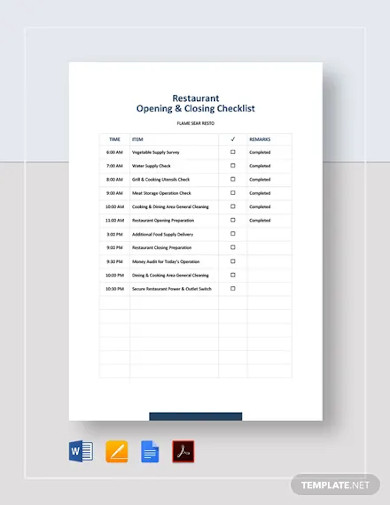
4. Restaurant Manager Opening Checklist Template
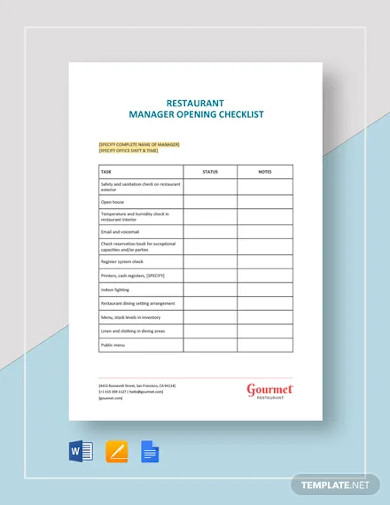
5. Restaurant Pre-Opening Checklist Template
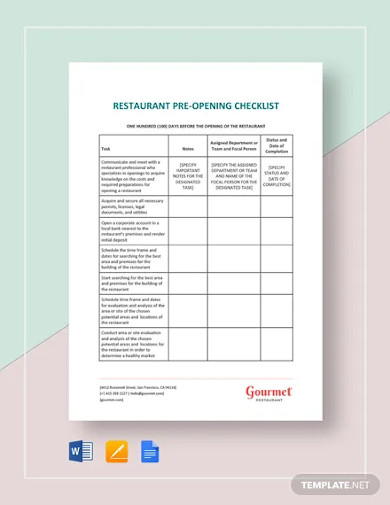
6. Hotel Re-Opening Checklist
7. Business Account Opening Checklist
8. Re-Opening Checklist
9. Workplace Re-Opening Checklist
10. Partial Opening Checklist
What is an opening checklist?
An opening checklist is like a reminder to perform tasks. Usually, it will enable you and the team to stay more organized during hectic periods. Since there are many things to prepare when opening, the manager will already designate everything to all the crew. It’s to avoid confusion and trouble during the process.
Here are some of the daily opening checklists that you should keep in mind:
- Clean the floors, tables, and kitchen
- Assure the bins are empty
- Restock tabletop necessities
- Check registers to know if they’ve effectively cleared from the previous shift
How to create an opening checklist?
Operating a restaurant or store is one of the dreams of many aspiring business owners. However, not all of them are fully aware of the proper way of how to create an opening checklist. Although this might sound normal, especially for beginners, it’s vital to educate yourself.
To help you, here are lists that you should consider:
1. Create a Business Plan
Before you open a restaurant, store, or account, make sure to create a business plan. You can always start by creating a brief background of what your business is. After that, generate a short description of your company, service or product line, market analysis, funding, and many more. If you lack knowledge about it, you can always check online. Make sure to read everything and apply it.
2. Know Your Budget
Obviously, no one can run a business without money. That’s why you need to set your budget first. By doing so, you will know if you need financing for your store or not. If you do, then you can begin investing.
3. Choose a Business Name
Next in line is creating a name that will stick in your target audience’s heads. Make sure that you are not taking it from another company. It’s because you might be in trouble if you do so. For your safety, do thorough research and see if the name you have in mind is unique.
4. Get a Business License
As a business owner, you should be aware of the importance of a license. Since not all states require proper licensing, it’s a factor that you need to check on. Once you discover that your state also needs one, you should process it right away. Having a proper permit or certification can give you the privilege to operate wherever your business is in your city.
5. Look For a Place
Where are you planning to build your business? Is it in your provide or city? Either of such, make sure to pay attention to accessibility, foot traffic, and other factors that may affect the number of people walking in your store. Opt for a location that can boost your company’s long-term performance.
6. Hire a Trusted Employee
Whether you have a store or restaurant, it’s a good idea to be alone all day. Of course, there is a lot of tasks to do. How can you manage everything when no one can assist you? It might only take you away from growing the business. So, better outsource interns, freelancers, or even third-party vendors.
FAQs:
What’s a restaurant or store checklist?
A restaurant or store checklist is an evaluation tool used to quickly determine or solve issues that might impact the business.
What’s the goal of creating a checklist?
An opening or closing checklist is a kind of job which helps lessen failure by compensating for possible limits of human attention and memory. Aside from that, it helps ensure completeness and consistency in handling a task. Commonly it’s known as a “to-do list”.
What are the different kinds of the checklist?
There are different kinds of checklists when running a business. Some of such are the “To-Do” checklist, procedure verification, troubleshooting checklist, and many more.
For a store or restaurant to run smoothly, all the staff should use their time efficiently. Cut back labor costs by providing them tasks that need to get done. That’s why it’s necessary to learn to create a detailed and proper opening and closing checklist for your business.


